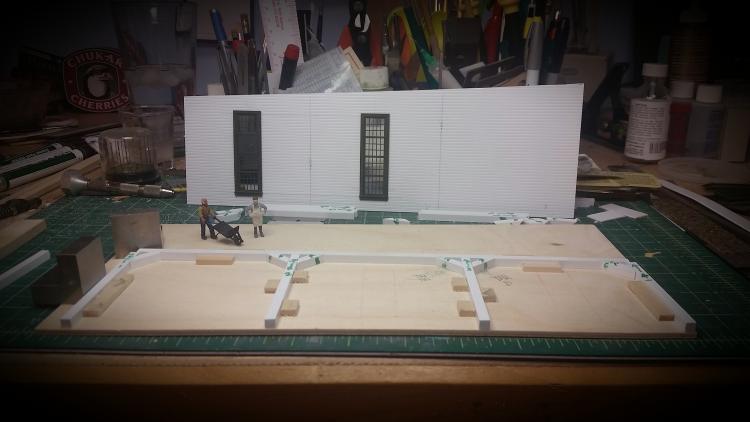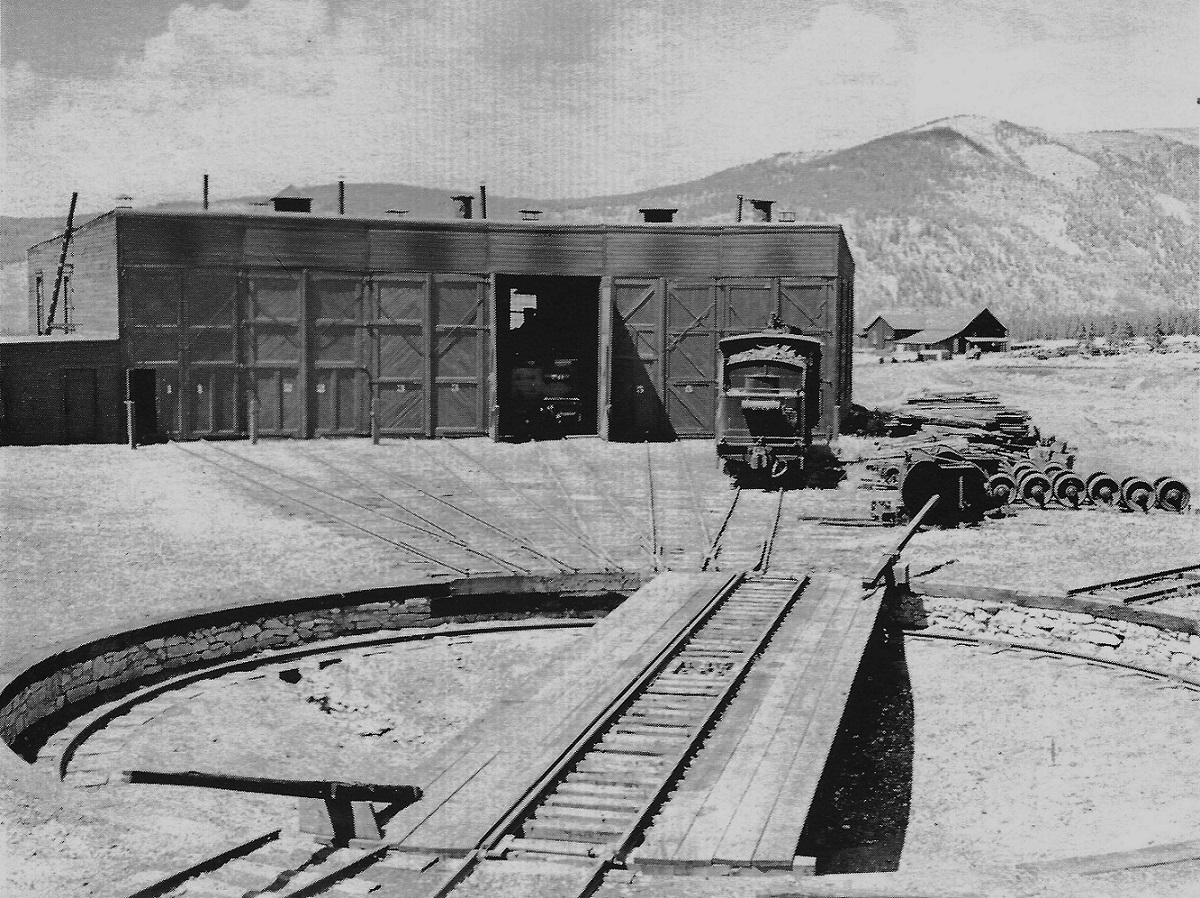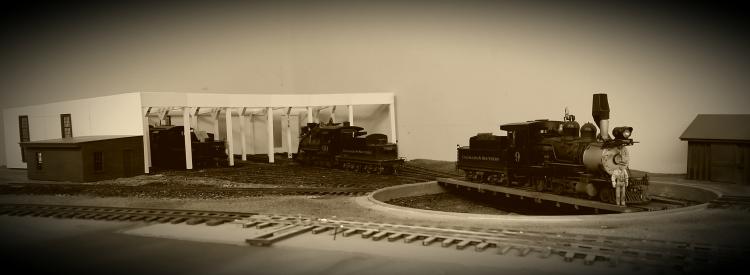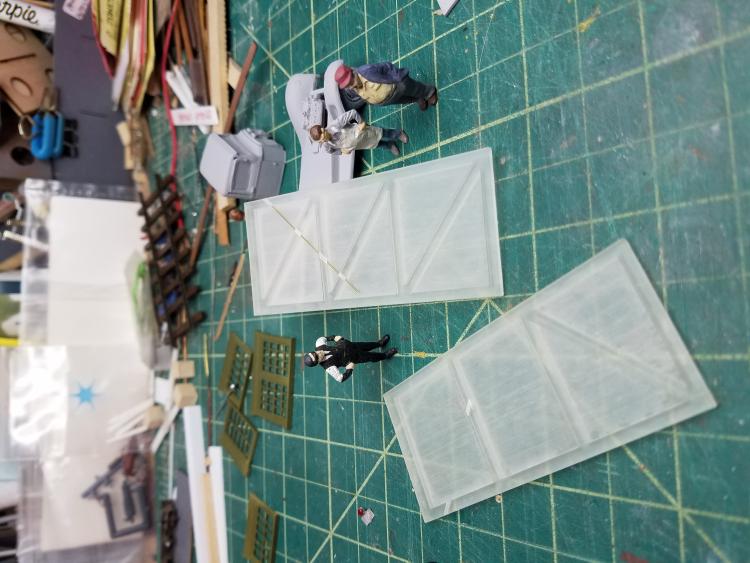Leadville Turntable
1234













1234
|
But Jeff, both Golden and Leadville used the Sellers Turntable. The one that you photographed on the Loop is from Alpine Tunnel.
Rick |
|
Leadville didn't always have a Sellers, see the DPL picture posted earlier in this thread. http://c-sn3-discussion-forum.41377.n7.nabble.com/Leadville-Turntable-tp3691p3703.html
UpSideDownC
in New Zealand |
Re: Leadville Roundhouse Progress
|
In reply to this post by Keith Hayes
Two bents and a side wall down.
 Anyone want to venture a guess as to the color in the 30s? Mineral Brown? Red to match the freight cars?
Keith Hayes
Leadville in Sn3 |
Re: Leadville Roundhouse Progress
|
You can never go wrong with C&S freight car red!!
Question is, were the windows and trim painted green? Jim
Jim Courtney
Poulsbo, WA |
Re: Leadville Roundhouse Progress
|
In this Richard Jackson photograph, from the CRA 12, the whole roundhouse looks one color:

Jim Courtney
Poulsbo, WA |
Re: Leadville Roundhouse Progress
|
Also interesting is the present of frogs on the roundhouse tracks. Question, were frogs present on other C&S roundhouse tracks? If so where? They were not present at Como. Why were they employed at Leadville? Thanks in advance.
Lee Gustafson |
Re: Leadville Roundhouse Progress
|
Frogs were needed to "correct" the intersection point of the stall tracks with the TT. The center point of the turntable was not the center point of the stall tracks so they had to cross. If the TT was closer to the building then they would not be needed. Bill Uffelman On Tuesday, March 8, 2016 9:09 AM, Lee Gustafson [via C&Sn3 Discussion Forum] <[hidden email]> wrote:
Also interesting is the present of frogs on the roundhouse tracks. Question, were frogs present on other C&S roundhouse tracks? If so where? They were not present at Como. Why were they employed at Leadville? Thanks in advance.
Lee Gustafson If you reply to this email, your message will be added to the discussion below:
http://c-sn3-discussion-forum.41377.n7.nabble.com/Leadville-Turntable-tp3691p4941.html
To start a new topic under C&Sn3 Discussion Forum, email [hidden email] To unsubscribe from C&Sn3 Discussion Forum, click here. NAML |
|
In reply to this post by Rick Steele
Rick, there are two different turntable spans on the loop today. The former turntable from Alpine Tunnel is near the former abutment that this bridge was supported by or below the Lebanon Mine Platform. The girders or span from what I believe was the second Leadville turntable is on the former Hwy 6 ROW above or north of the Devils Gate Viaduct.
|
Re: Leadville Roundhouse Progress
|
In reply to this post by Keith Hayes
I think there is color footage of the Leadville roundhouse in the WB Productions VHS tape "Excursion To The Thirties" if you have or can find a copy.
|
Re: Leadville Roundhouse Progress
|
In reply to this post by Keith Hayes

Keith Hayes
Leadville in Sn3 |
|
In reply to this post by Chris Walker
You mentioned, "Patrick Tillary--who modified an HO Walthers model to a 65-footish S-scale bridge--advised me that the indexing memory was volatile. He had to re-index the tracks if he unplugged the power for the table".
Now I ask the obvious, how could Walthers sell something like that, get rave reviews in all the magazines when it first came out, and only a few folks knew of the very serious design deflect? Makes me afraid of just how much power Walthers has in the hobby. Gerry |
Re: Leadville Roundhouse Progress
|
In reply to this post by Lee Gustafson
One challenge modelling roundhouses involves the dimensional relationships. Often, though not always, there is sufficient room on the lead between the pit and the building to store a whole locomotive (convenient when firing up a cold boiler). Equally often there is a minimum of space between tracks at the face of the building: often just enough for thecolumn supporting the roof and adjacent doors. These relationships result in closely spaced radial tracks and the face of building a ways back from the pit. As the face of building moves away from the pit, the converging tracks are more closely spaced, to the point of overlap as at Leadville. This also maximizes the possible number of radial tracks.
It appears to me that the face of building is far enough back that it was almost--almost possible to store locomotives outside on adjacent tracks. Certainly on alternate tracks. Modelling this to scale would require a lot of space. On the valuation map, it appears the doors are over 100 feet from the pit. My model has the rails side by side at the pit and I have about 68 feet. Including a locomotive length on the lead, my model is about four feet from lead to back wall of building. Check out the Walthers roundhouse model: the face of door is within 10 scale feet of the pit--a door swing. The radial tracks are more degrees apart and fewer tracks are possible. This all takes much less space on a model pike. I considered a spacing that would use frogs, but didn't want to tempt fate. Having space between the doors and the pit to store a locomotive was sufficient for me. Rick mentioned whisker tracks, the tracks across the pit that allows crews to maneuver dead locomotives. I am curious that these do not appear to be common on the narrow gauge. The valuation map and photos don't indicate them at Leadville; I have not noted them at Como, and don't recall track of significant length at Chama. At Chama, the lead does align with one stall, and the same is true at Leadville. I wonder if a fire had to be dropped if locos were spotted on those tracks? Also, I speculate that significant maintenance was only done on a limited basis Denver (Alamosa and Salida ) being preferred. At Como, the lead tracks aligned with the wood stalls, almost 90 degrees to the standing stone building.
Keith Hayes
Leadville in Sn3 |
|
In reply to this post by usairman737
How does the mechanism in the near foreground work to lock the table in position? I've seen sliders that do the function, but this appears to use a rod in some way.
Gerry |
|
In reply to this post by usairman737
Gerry, that is what I understood Patrick to say. Perhaps I misunderstood. Jack Walton assured me this is not an issue with his controller. My concern stems from the fact that I turn off all the power to the layout when I am not in the room. We found out on another layout a month ago that when you dispatch a loco using the Digitrax system, you need to verify that the loco is at speed step zero. The loco in question was at speed step 1 and ended up wandering a long ways before it was found!
Keith Hayes
Leadville in Sn3 |
|
In reply to this post by usairman737
Gerry, I trust you mean in the prototype photo? As near as I can tell, the C&S used an "I" shaped piece of steel between the rails at the web. It looks like the hostler got to slide this off the bridge to lock in the lead tracks.
Also...it appears in the photo that neither lead track at Leadville aligned with the stalls. Hmmmm.
Keith Hayes
Leadville in Sn3 |
Re: Leadville Roundhouse Progress
|
In reply to this post by Keith Hayes
I was going to post a progress image last week, but when I examined the photo, I saw a glitch.
 The siding above the track to the right looked odd. I thought about it all week and determined one of the bents was not seated, causing a bulge that I had reinforced. So, out came the razor blade and off came some parts. Withe the help of some straight edges and squares, I was able to rectify matters.  Guess it is time to start modelling those track doors!
Keith Hayes
Leadville in Sn3 |
Re: Leadville Roundhouse Progress
|
Test fit.

Keith Hayes
Leadville in Sn3 |
Re: Leadville Roundhouse Progress
|
Doug Ozment, son of D&RGW employee Jim Ozment, posted some of his Dad's photos on Facebook. A couple included some images of the C&S facilities in Leadville in the 1950s:
 This answers the questions, "what color is the roundhouse?" and, "are the windows the same color?" I have been studying the roof details of late. Looks like there are three 55-gallon drums along the facade above the doors, and after the building was standard-gauged, they kept the old fire barrels and added three new ones along the face of the addition. Also, there are a couple peaked vents, and 4-5 smoke jacks, but never six. Hmm.
Keith Hayes
Leadville in Sn3 |
Re: Leadville Roundhouse Progress
|
In reply to this post by Keith Hayes
After a 4-hour marathon with Sketch Up, the roundhouse doors are modeled. They seem to be uploaded okay, so I will order a test part. All the doors are different, of course.
Keith Hayes
Leadville in Sn3 |
Re: Leadville Roundhouse Progress
|
This post was updated on .
The test print of the stall 6 door came today. A 1 week turnaround. None of the T&G grooves rendered, but by golly, the 1" diameter hole for the brace sure did! (This before I studied one of the pics Jim posted and figured out the rods are applied to the face.)

Keith Hayes
Leadville in Sn3 |
«
Return to C&Sng Discussion Forum
|
1 view|%1 views
| Free forum by Nabble | Edit this page |

